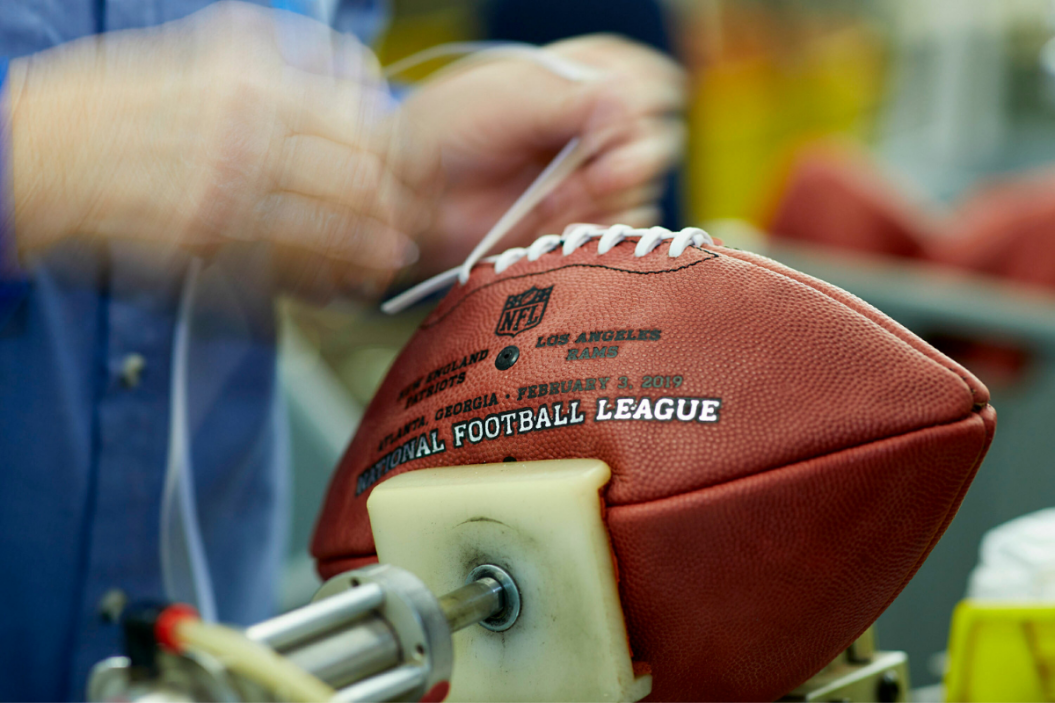American football is my lifeblood. From the time I entered this world, my parents dressed me up in Pittsburgh Steelers gear and baptized me into the game. I played all through school, briefly in college and never shy away from the annual Turkey Bowl game with my friends. Whether you're more of a college football or National Football League fan, Americans just love tossing around the old pigskin.
Videos by FanBuzz
But did you ever stop and think why footballs are called pigskins? It might surprise you to know that pig skin has nothing to do with how footballs are made today, and they weren't even made of pig skin back in the day.
Why Are Footballs Called Pigskins?
Did you know pig bladders were historically used as the airtight membrane ("bladder") inside a football? The nickname #pigskin stuck! #BladdersMatter #BladderHealthMonth #bladderfunfacts @UrologyCareFdn @NFL @AmerUrological pic.twitter.com/fnfHZHaeQH
— Dr Johanna Hannan (@Hannan_Lab) November 4, 2018
When footballs were first made, they were actually inflated animal bladders (gross) stuffed with things like straw to keep them firm. Naturally, tossing around an inflated organ was getting messy, so these early footballs were wrapped in leather to keep them clean. Because pig bladders were among the most readily available back then, wrapping them in cowhide leather gave birth to the "pigskin" moniker despite a pig's skin not being part of the equation.
Thankfully for all of us, inflated bladders weren't commonly used as the game developed, giving way to the modern footballs we toss around at the beach today. And you know what, "throwing the ole pigskin" sounds a lot better than "throwing the ole pig's bladder."
What Are Footballs Made Of?
Sitting at home, staring at your football collection and wondering how it's all made? well, here you go. #wilsonfootball pic.twitter.com/rY6zpyuNmp
— Wilson Football (@WilsonFootball) March 23, 2020
When engineer and chemist Charles Goodyear — yes, the tire guy — accidentally invented vulcanized rubber in 1844, footballs took on their modern form. Wrapped in leather coverings to make the balls easier to handle led to the addition of laces. Different sizes were developed as the game expanded to all age groups, and voila! The footballs of today were born.
NFL footballs used in every Super Bowl since the very first in 1967 are made of either polyurethane or rubber and are produced by Wilson Sporting Goods in Ada, Ohio. Horween Leather Co. in Chicago, Illinois, supplies the leather for those game balls and is the only American company to do so. Horween provides leather for other uses to Nike, Under Armour and adidas, but only the Wilson factory turns that synthetic leather into official balls, according to USA Today.
NFL game balls are commonly known as "The Duke." They're nicknamed after Wellington Mara, the beloved New York Giants owner who started as a ballboy with the team back in 1925.
The lacing on today's footballs are actually only one lace that is hand-woven through 16 holes to create the perfect, 8-lace grip that holds the leather panels together. Each Wilson football is sewn together using 250 stitches, also done by hand.
Multiple variations, from adding white stripes to the AAF's computer-chipped balls, brought us where we are today, tossing around that football-shaped thing that, in reality, actually has a name.
What Shape is a Football?
If you’re talking to a mathematician, the shape of a football is best described as a “prolate spheroid.” But everyone will know what you’re talking about if you just say “football-shaped.” #SuperBowl pic.twitter.com/bkH2Xvh63g
— Mental Floss (@mental_floss) February 4, 2019
RELATED: College Football Trivia: What Does 'FBS' and 'FCS' Actually Mean?
Sadly, "football" is not a real geometric shape. Footballs are more commonly known as prolate spheroids. The invention of the forward pass makes the prolate spheroid easier to throw through the air for football players, even if the odd shape gives kickers at all levels fits. I don't know about you, but I'm just going to keep calling them football-shaped things.
You can read all about how to calculate the ellipticity and surface area of a leather football at MathWorld.com. (I spent 10 minutes looking at these equations before my brain started hurting.)
How Big is a Football Field?
What the dimensions could look like for a football field in the infield at Bristol Motor Speedway pic.twitter.com/Ej8fSk2cf5
— @GrantRamey (@GrantRamey) October 10, 2013
Most of us know the first important dimension of a football field: length. Goal line to goal line, American football fields are 100 yards long. Add the end zones, and you're looking at the full 120-yard field found at every site across the country regardless of skill level. Here are some other dimensions you may not have known, though:
Length: 120 yards
Width: 53.5 yards
Square feet: 57,600
Acres: 1.32
Width between hash marks: 53 feet, 4 inches (high school); 40 feet (college); 18 feet, 6 inches (NFL)
Goalpost width: 18.6 feet wide (NFL and NCAA); 23 feet, 4 inches (high school)
Goalpost height: 10 feet (crossbar); 30 feet (total height in NFL)
Enjoy these random facts about the game of football that hopefully come in handy for your next trivia night, or just impress a few friends at the Super Bowl party with your unflappable knowledge of random football facts.
Editor's Note: Products featured on FanBuzz are independently selected by our editors. However, when you buy something through our links, we may earn a commission.
This post was originally published on March 25, 2020.


